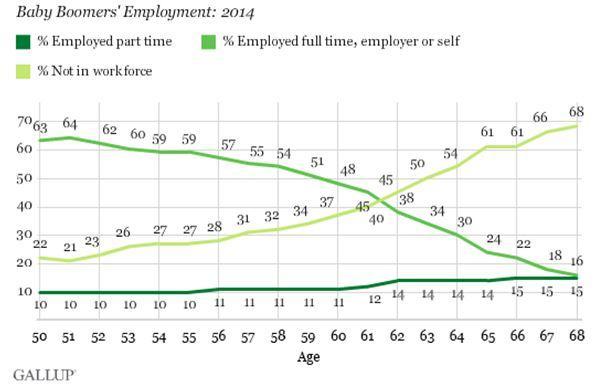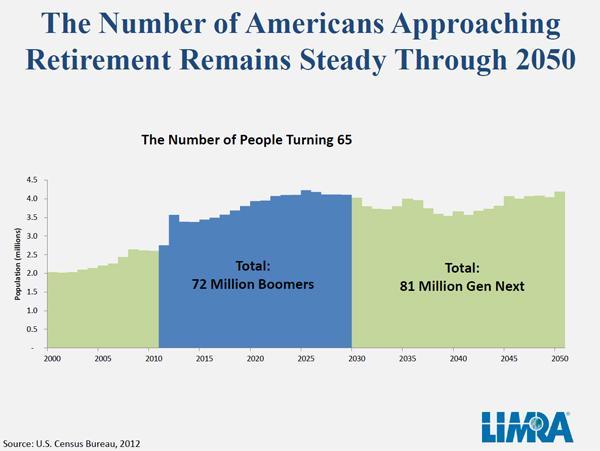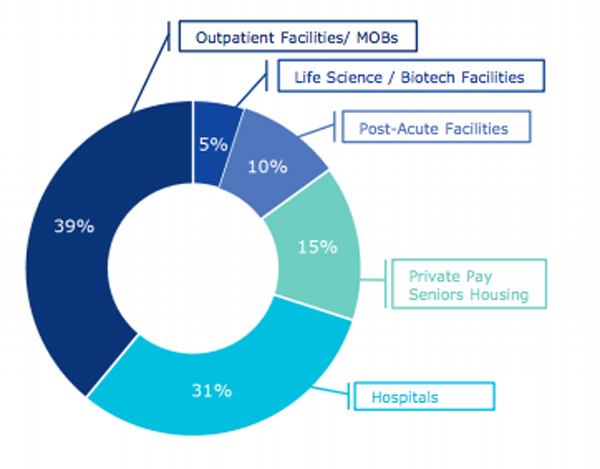Baby boomers are retiring in incredible numbers – 10,000 a day according to Social Security eligibility. A large majority of these are flush with the dual rewards of stock market investments and Social Security income.
But like death and taxes, growing old is an eventuality that we all must face. The details of how long we live – and where we do it – are as much dependent upon our health as they are money. The one thing we can say for sure is that it’s not getting any less expensive to live longer.
It’s why the senior housing industry and these two REITs – Welltower (HCN) and Ventas (VTR) – are permanently attached to my watch list.
Senior Living’s Greatest REITs
The real question has been whether or not the Great Recession hurt the boomers enough to delay their retirement. The answer seems to be a resounding no – seniors are retiring on time, and leaving the workforce.
Baby Boomers’ Employment: 2014

Last year’s Gallup polls showed that many are retiring, and few are choosing to continue working part-time. It’s why we’ve seen a construction boom in senior living facilities over the past few years.
What’s more, the facilities that health care companies are buying and building for baby boomers will be ideally placed to handle the echo of their children, the Generation Next as they start retiring in 2030.
The Large Number of Americans Turning 65 Is Steady Through 2050

Now, it used to be that there were plenty of public leaders in the senior housing space – and plenty of investment options.
But in the aftermath of the financial crisis where many of these healthcare stocks went private, merged or were bought out, today there exist few large providers available to investors.
What we are left with are two substantial healthcare REITs: Welltower and Ventas, which have swallowed up their competition. In short, they dominate the market.
Ventas (VTR)
Satisfying my need for contrarian value, Ventas is sitting just under 30% below its 52-week high. It delivers a $2.92 dividend that yields a healthy 5.2%. The stock has a 10% YTD dividend growth rate and a 7.6% five-year dividend growth rate.
Ventas focuses its Senior Living portfolio with service providers Sunrise and Atria. Just over 90% of their portfolio is with these two operators. It means that they have less internal competition amongst their own facilities.
Ventas has seen its funds-from-operations (FFO) grow by a compounded growth rate of 10.9% over the past five years, versus 7.2% from HCN. Either way, it means these companies are making profitable investment decisions.
The growth of FFO is a better measurement of performance for a REIT than typical EPS. Ventas has an enterprise value of $29.7 billion and holds 1,288 properties.
Welltower (HCN)
The larger of the two, Welltower is roughly 18% below its 52-week high. The company delivers a $3.30 dividend yielding 5%. There’s good reason to think HCN might increase its dividend again this year.
The firm has raised its dividend just about every year since 2003 and maintains a string of 178 quarterly payouts. The YTD dividend grow is 4% with five-year dividend growth rate coming in a just 3.2%. It’s conservative, but careful.
Welltower has diversified its operators amongst Brookdale, Belmont, Revera, and Benchmark. Sunrise is their largest holding. This diversification helps minimize portfolio risk of fewer operators, but does increase competition amongst its facilities in markets where they are concentrated.
Welltower has an enterprise value of $34.9 billion and holds 1,414 properties
Both of these health care REITs are carefully managed and well run. They overlap in regions, providers and individual markets. It can be hard to isolate one without talking about the other simply because of this proximity and similarity of asset types.
One of the most interesting aspects of this industry is that the vast majority of their income comes from private pay sources like insurance and customer assets. Welltower has roughly 87% private pay income.
In most states Medicare cannot be used for assisted living, and the few exceptions are modified state programs or when an individual has run out of assets and Medicaid steps in. Medicare covers only short-term care like rehab stays in a nursing home.
If the Federal rules on Medicare change even slightly, it could open vast new sources of revenue for the operators. Think what Federal Loans did for for-profit colleges and you can imagine the kind of gold rush we could see.
The U.S. healthcare real estate market is still very fractured. Welltower is by far the largest public player in the space, and yet it holds just a 2.5% market share. As an industry, REITs hold just 15% of the total real estate in Healthcare. We can look forward to years of consolidation and growth as these two larger operators absorb smaller ones.
There’s another opportunity as these two companies increase their holdings of outpatient medical office buildings (MOBs) and Hospitals. Private pay senior housing represents just 15% of the $1 trillion health care real estate market.
The $1 Trillion U.S. Real Estate Market

Hospitals and MOBs represent 31% and 39%, respectively, of that total healthcare real estate and are another growth opportunity for HCN and VTR – both of which have plenty of investment capital and money from operations.
Remember, they’re capitalizing off the biggest demographic shift in American history. Here’s what driving the America-is-getting-older trend:
- There are 72 million Baby Boomers who are started to retire.
- These seniors are living longer than ever – the Society of Actuaries recently amended its mortality tables to give a 65-year-old male a life expectancy to age 86.6 and a 65-year-old woman a life expectancy to age 88.8.
- The 85+ population will triple over the next 30 years.
The longer everyone lives, the more likely it is that they’ll need someone to help take care of them. About 70% of Americans who reach age 65 will need some form of long-term care and for an average of three years.
As much as I like VTR and HCN, I’m even more excited about a new company in the space that’s actually led by a group of former VTR executives. It’s a direct play on senior housing facilities. The REIT pays an amazing 7.5% yield that’s not only safe, but likely to grow significantly with the market in the years ahead.
Get the full details on this “perfect income investment” right now AND the details on how my second-level analysis uncovered it.
